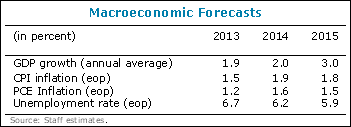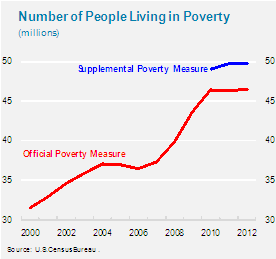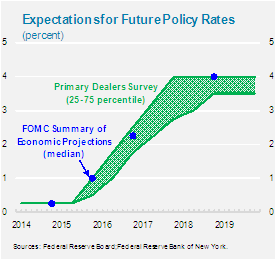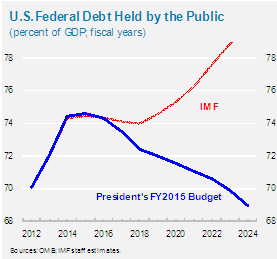2014 Article IV Consultation with the United States of America Concluding Statement of the IMF Mission
June 16, 2014
Describes the preliminary findings of IMF staff at the conclusion of certain missions (official staff visits, in most cases to member countries). Missions are undertaken as part of regular (usually annual) consultations under Article IV of the IMF's Articles of Agreement, in the context of a request to use IMF resources (borrow from the IMF), as part of discussions of staff monitored programs, and as part of other staff reviews of economic developments.
The 2014 U.S. Article IV highlighted five broad themes to both strengthen the recovery and improve the long-term outlook: raising productivity growth and labor participation, confronting poverty, keeping public debt on a sustained downward path, managing the exit from zero policy rates, and securing a safer financial system. To achieve these goals and fortify the country’s economic future the policy focus should be to undertake more proactive labor market policies that lower long-term unemployment and raise participation; increase the minimum wage while strengthening the Earned Income Tax Credit; invest in infrastructure; improve the tax structure and raise revenues; fundamentally reform social security; and lower the growth of health care costs.
Growth and Poverty Reduction

1.Near-term growth and jobs. In the early part of this year, as a harsh winter conspired with other factors (including inventory drawdown, a still-struggling housing market, and slower external demand), momentum faded in the U.S economy. Recent data, however, suggest a meaningful rebound in activity is now underway and growth for the remainder of this year and 2015 should well exceed potential. This renewed dynamism, however, provides only a partial offset to the weak first quarter and so growth is now projected at 2 percent for 2014, rising to 3 percent in 2015. As the economy strengthens, the current account deficit is expected to slowly widen with an increased demand for imports only partially offset by fiscal consolidation and the improvements in the trade balance that are linked to rising self-sufficiency in energy. Despite the cyclically-adjusted current account being somewhat on the weaker side, the U.S. external position appears broadly consistent with medium-term fundamentals and desirable policies. Job growth has been healthy but labor markets are weaker than is implied by the headline unemployment number: long-term unemployment is high, labor force participation is well below what can be explained by demographic factors, and wages are stagnant. With better growth prospects, the U.S. should see steady progress in job creation. However, headline unemployment is expected to decline only slowly—in part because improving prospects will draw discouraged workers back into the labor force—and long-term unemployment will take time to fall to historic levels.
2. Longer-run growth. Potential growth is forecast to average around 2 percent for the next several years, below both historic averages and the outlook assessed at the last Article IV consultation. A combination of factors is at work in lowering longer-run growth including the effects of population aging and more modest prospects for productivity growth. This puts a significant premium on taking immediate steps to raise productivity, encourage innovation, augment human and physical capital, and increase labor force participation. Such measures should involve investments in infrastructure and education, improving the tax system, and active labor market policies. They may also include reaching agreement on a broad, skills-based approach to immigration reform (to expand the labor force, raise average labor productivity, and support medium-term fiscal adjustment) as well as fully capitalizing on the gains from rising U.S. energy independence while protecting the environment (including by removing existing restrictions on U.S. oil exports). No single measure will be sufficient and a manifold solution will certainly be required. There is no shortage of good ideas currently under public debate and so the challenge ahead is to forge political agreement on specific legislation.

3. Poverty. The latest data showed almost 50 million Americans living in poverty (as measured by the Census Bureau’s supplemental poverty measure) and the official poverty rate has been stuck above 15 percent despite the ongoing recovery. Reducing poverty will require, first and foremost, a much more robust return to growth and job creation. However, other policies have a role to play. The recent expansion of Medicaid and the increase in health insurance coverage have been concrete steps whose effect on poverty and health outcomes should become more evident over time. An expansion of the Earned Income Tax Credit—to apply to households without children, to older workers, and to low income youth—would be another effective tool to raise living standards for the very poor. Similarly, the government should make permanent the various extensions of the EITC and the improvements in the Child Tax Credit that are due to expire in 2017. Finally, given its current low level (compared both to U.S. history and international standards), the minimum wage should be increased. This would help raise incomes for millions of working poor and would have strong complementarities with the suggested improvements in the EITC, working in tandem to ensure a meaningful increase in after-tax earnings for the nation’s poorest households.
Macroeconomic and Financial Policies
4. The macroeconomic policy mix. Given the substantial economic slack in the economy, there is a strong case to provide continued policy support. Ideally, steps should be taken to approve and implement a credible medium-term fiscal consolidation plan so as to provide the flexibility for more near-term fiscal support to the economy. Such fiscal support should be designed with a heavy focus toward encouraging longer-term gains to productivity, the capital stock, and labor supply. Helping to kick-start growth and job creation in this way would allow for an earlier withdrawal of exceptional monetary stimulus which, in turn, would alleviate the potential risks to both domestic and international financial stability posed by the protracted period of exceptionally low policy rates. This would be the best policy mix from an economic perspective but, regrettably, political agreement on such an approach remains elusive.

5. Monetary policy stance. The Fed currently has to contend with multiple areas of uncertainty: the degree of slack remaining in U.S. labor markets; the extent to which this slack will translate into future wage and price inflation; and the transmission to the real economy of a future move upwards in policy rates. These substantive ambiguities make the outlook for U.S. monetary policy particularly uncertain, as the Fed has repeatedly communicated. This incertitude stands in contrast to the narrow range of market views on the path for future policy rates as well as the current historically low pricing of asset price volatility. At the same time, longer-term treasury yields and the term premia have been compressed to very low levels. This sets up the risk, even with a successful and well-communicated increase in interest rates, for significant swings in market flows and prices in the months ahead. If such volatility were to unfold, it would have implications that would reach far beyond U.S. borders, potentially straining those countries with weaker fundamentals which could then have second round effects for U.S. growth. Under the staff’s baseline, the economy is expected to reach full employment only by end-2017 and inflationary pressures are expected to remain muted. If true, policy rates could afford to stay at zero for longer than the mid-2015 date currently foreseen by markets. Policy would, however, have to remain cognizant of financial stability risks, particularly those that are inherently difficult to contain through available regulatory and supervisory tools. If inflation were to rise more rapidly than expected and the economy was still well below full employment, tolerating a modest, temporary rise of inflation above the longer-term goal could be consistent with the Fed’s balanced approach as long as inflation expectations remain anchored and financial stability risks were low.
6. Federal Reserve communication. The Fed has made important and substantive efforts to increase transparency and has adopted an adaptable approach to communication. The recent shift to qualitative forward guidance provides the Fed with greater flexibility but puts an even higher premium on clear and systematic communication to guide expectations, particularly given the potential adverse consequences of miscommunication for international markets. Enhancing the Fed’s communication toolkit would be a natural evolution that could help temper the likelihood of market volatility along the exit path. This could include scheduling press conferences by the Fed Chair after each FOMC meeting (to provide a more frequent, structured environment to explain the committee’s evolving thinking). It could also involve publishing a quarterly monetary policy report, that is endorsed by the FOMC and which conveys more detail about the majority view of the FOMC on the outlook, policies, and the nature of uncertainties around the baseline. Such a report may also convey dissenting views on the FOMC as well as broader information on how the FOMC thinks about policy reactions in plausible, non-baseline scenarios. Finally, the FOMC could provide greater clarity about how financial stability considerations figure into its monetary policy calculus.
7. Financial stability risks. Over the past few years, much has been done to reduce financial system risks: the banks are stronger, corporate balance sheets are healthy, overall leverage is contained, and the regulatory framework has been greatly improved. Nevertheless, the prolonged period of very low interest rates continues to raise financial stability concerns, particularly related to activities in the so-called “shadow” banks and in other nonbank intermediaries including:
• The growing amount of maturity and liquidity transformation that is taking place through mutual funds or exchange traded funds, particularly those investing in credit instruments;
• The ongoing weakening of underwriting standards in some areas, particularly those linked to lending to leveraged corporations with higher credit risks;
• The volume of flows that is searching for returns and flowing into higher credit risk and longer duration assets;
• The uncertain leverage and risks that are embedded in securities lending undertaken by large financial institutions;
• The fragmented oversight of the insurance sector, data gaps, and the lack of a consolidated picture of insurance companies’ global activities and risks;
• A decline in broker-dealer involvement in market making activity, potentially hampering the functioning of markets and price discovery at times of market stress.
Some broad combination of these pockets of evolving vulnerabilities—set against a backdrop of a rise in short-term interest rates or an unwinding of currently compressed risk and term premia—could prove disruptive. In particular, a tail risk where there was a precipitous attempt by investors to exit certain markets—perhaps exacerbated by outflows from ETFs and mutual funds as well as near-term market illiquidity—could trigger an abrupt and self-reinforcing re-pricing of a range of financial assets. This, in turn, could have damaging implications for U.S. growth (through wealth effects, difficulties in rolling over or accessing new financing, and strains in the corporate sector) and negative knock-on effects internationally.
8. Regulatory action. Steps that could be taken to tackle these risks and lessen the likelihood of negative spillovers to the global economy include further supervisory scrutiny on underwriting standards, higher risk weights and tighter limits on large exposures to certain assets (such as leveraged loans or high yield bonds), and stronger prudential norms for the holding of securitized loans (such as CLOs) by regulated entities. Addressing the remaining vulnerabilities of the money market funds and of the tri-party repo market also remains a priority. In addition, the U.S. should continue to implement measures that allow for the orderly resolution of too-important-to-fail financial institutions, including through deepening the cooperation with other jurisdictions to manage the resolution of institutions with a significant cross-border presence. The insurance sector warrants particular attention and would benefit from stronger and more uniform capital adequacy and solvency oversight standards, refinement and harmonization of stress testing exercises, greater efforts to close data gaps, further designation of systemically important firms, and a larger federal role in insurance regulation and oversight. The U.S. should also continue to play a lead role in advancing the global regulatory reform agenda, ensuring common practices across countries, and limiting the opportunities for regulatory arbitrage while remaining attuned to the spillover implications of regulatory changes on the international financial system.
9. Housing finance. Limited availability of mortgage financing is a pressing constraint on economic growth. Conservative lending standards are being driven by a range of factors that include persistent anxiety about potential “put-back” risks (i.e., where Fannie Mae or Freddie Mac require mortgage originators to repurchase loans because of discrepancies in underwriting or documentation); litigation and reputational risks to lenders; a tighter regulatory environment and supervisory scrutiny; and uncertainty about the future structure of the mortgage industry. Policy efforts have been made to lessen the impact of some of these factors including by establishing a “safe harbor” for Qualified Mortgages that meet a clear set of minimum standards and by clarifying the conditions for put-backs. However, the recovery of mortgage lending to lower credit rated borrowers is likely to be a slow process. Legislative reforms that clarify the future role of government in housing finance would help. The end objective should be a system where there is:
• A substantial first-loss risk borne by private capital (rather than taxpayers);
• An explicit public backstop that is limited to catastrophic credit losses with risk-based guarantee fees;
• A role for regulatory agencies in setting underwriting standards;
• A common platform for securitization; and
• A clear delineation and transparent accounting of those public interventions in the housing market that are intended to promote social objectives.
While reaching agreement on legislation will be hard, in anticipation of broader legislative reform many of these objectives can still be realized in the medium term through administrative action including by expanding the use of market transactions to transfer first-loss risks from the agencies to private investors; moving gradually to higher and more risk-based guarantee fees; steadily building up capital within the agencies while reducing their role in housing finance; and establishing a single securitization platform.
10. Near-term fiscal policy. The difficulty of finding political common ground on fiscal policy has been very evident over the past few years with negative consequences for both the U.S. and global economy. The Bipartisan Budget Act, enacted in December 2013, and the subsequent raising of the debt ceiling were important steps to reduce fiscal risks and improve both the pace and distribution of near-term deficit reduction. Going forward, even in the absence of a fully articulated medium-term consolidation plan, there is room to build on this progress through the identification of targeted areas to expand the near-term budget envelope, funded by offsetting savings in future years. Specific near-term measures that should be supported—many of which were in the Administration’s budget proposal—include:
• Front-loaded infrastructure spending. Additional investment is urgently needed to upgrade the quality of infrastructure in the U.S., particularly for surface transportation. Most pressing is the need to provide clarity on future financing of the Highway Trust Fund. However, this should be viewed only as a first step. Action is also needed to achieve a sustained increase in both Federal and State spending on infrastructure paid for by savings in entitlement programs, additional revenues, and an expansion of financing sources (including innovations such as the America Fast Forward Bond).
• Changes in the tax system. Itemized deductions for the individual income tax—including the mortgage interest deduction—should be either limited or gradually eliminated. The Federal gas tax should be significantly increased. The tax system could also be used more effectively to incentivize private innovation such as by reinstating and making permanent the Research and Experimentation tax credit that expired at end-2013. In addition, consideration should be given to offering time-bound tax credits or wage subsidies to employers who hire the long-term unemployed.

•Education spending. Educational outcomes could be raised by a reorientation of spending to prioritize early childhood education (including universal pre-K) and to give more support to science, technology, engineering and math programs.
11. Medium-term consolidation. Recent years have seen a rapid reduction in the fiscal deficit. Nevertheless, the general government debt is still not on a sustainable longer-term path and is likely to begin rising again by 2018. There is a pressing need to reach political agreement on a credible and detailed medium-term fiscal consolidation path. To meet the Administration’s goal of ensuring that debt is placed on a downward trajectory, staff believe that a general government primary surplus of 1¼ percent of GDP by 2023 will be needed. This adjustment will need to include measures to:
• Control health care costs. Some progress has already been made in taming the fiscal pressures from rising health care costs—in part through implementation of the Affordable Care Act—but more is needed. This should involve better coordination of services for those with chronic conditions; greater cost sharing with beneficiaries; and limiting tax breaks for higher cost, employer-provided health plans.
• Strengthen social security finances. Addressing the expected depletion of the social security trust fund will require fundamental reform that further raises the retirement age in a gradual manner (perhaps with a link to future life expectancy), increases the ceiling on taxable earnings for social security, and indexes benefits and tax provisions to chained CPI.
• Improve the tax structure and raise revenues. In addition to the near-term tax measures described above, a broad reform of corporate taxes is long overdue and should lower the marginal rate, simplify the system, eliminate a range of exclusions and deductions, and limit base erosion and profit shifting by multinational firms. In addition, the U.S. should introduce a broad-based carbon tax and move toward the introduction of a Federal-level VAT.
12. Institutional fiscal reforms. The recent experience of debt ceiling brinkmanship and the government shut down once again illustrates the potential economic damage from political discord linked to fiscal policies. There is a risk that, in the Spring of 2015, many of these issues will come to the fore once more. While not a panacea, some change to budget procedures could have a lasting effect in lessening such fiscal policy uncertainty. Useful measures could include reaching bipartisan agreement on a clear, simple medium-term fiscal objective (with an integrated view of all budget functions and numerical targets for the debt and deficit); adopting carefully-designed mechanisms to trigger revenue or spending adjustments if targets are breached; an automatic process that would raise the debt ceiling once agreement is reached on the broad budget parameters; and shifting to a budget cycle where annual spending levels are agreed for a two year period (but with the possibility for supplemental budget resolutions during that two year window under clearly specified conditions).
13. In conclusion, the agenda ahead is long and challenging and will take many years to accomplish. Concerted progress will serve to raise long-run growth prospects, lessen poverty, put fiscal finances on a sustainable footing, and reduce financial stability risks. All of which will be advantageous for the U.S. and for the world economy.
IMF COMMUNICATIONS DEPARTMENT
| Public Affairs | Media Relations | |||
|---|---|---|---|---|
| E-mail: | publicaffairs@imf.org | E-mail: | media@imf.org | |
| Fax: | 202-623-6220 | Phone: | 202-623-7100 | |


